Overview
The article emphasizes the pivotal role of chromatography in enhancing pharmaceutical lab operations through a range of applications and advancements in analytical techniques. It underscores that chromatography, especially High-Performance Liquid Chromatography (HPLC), is indispensable for ensuring drug purity and meeting regulatory standards. This technique facilitates the precise identification of compounds and contaminants, which significantly improves drug safety and effectiveness during pharmaceutical development. By integrating these advanced analytical methods, laboratories can achieve higher levels of accuracy and reliability in their processes, ultimately fostering greater trust in pharmaceutical products.
Introduction
In the realm of scientific research and quality control, chromatography emerges as an indispensable technique, bridging various fields from pharmaceuticals to environmental monitoring. Its capability to separate, identify, and quantify compounds not only enhances the accuracy of analytical methods but also plays a crucial role in ensuring safety and compliance across industries.
As advancements in technology reshape the landscape of analytical chemistry, the significance of high-performance liquid chromatography (HPLC) and other chromatographic techniques becomes increasingly clear. This article delves into the multifaceted applications of chromatography, examining its impact on:
- Drug purity
- Food safety
- Forensic science
- Beyond
Furthermore, it highlights the innovative solutions provided by JM Science Inc., empowering laboratories to meet the evolving demands of these critical sectors.
JM Science HPLC Solutions: Precision in Analytical Chemistry
JM Science Inc. delivers high-performance liquid chromatography solutions that are used chromatography for achieving accuracy in analytical chemistry. These systems are meticulously engineered to separate, identify, and quantify compounds in complex mixtures, a process that is crucial for pharmaceutical applications. The advanced technology integrated into JM Science's high-performance liquid chromatography systems enables precise measurements, ensuring that drug formulations meet rigorous quality standards. This capability not only enhances analytical accuracy but also significantly contributes to improved drug safety and effectiveness, which is why high-performance liquid chromatography is used chromatography in pharmaceutical applications.
As the market for HPLC continues to expand, projected to reach significant milestones by 2025, the demand for reliable and effective analytical techniques becomes increasingly critical. Recent advancements in HPLC technology, such as automated method development systems, have streamlined laboratory processes, enabling robust and validated methods to be delivered more efficiently. A notable example is the partnership between Thermo Fisher Scientific and ChromSword, which has produced systems that enhance laboratory efficiency, underscoring the continuous progress in this field.
Practical instances illustrate the transformative impact of high-performance liquid chromatography on analytical chemistry. Laboratories that used chromatography with JM Science's HPLC solutions report substantial improvements in their analytical capabilities, which lead to enhanced drug formulation quality and compliance with regulatory standards. Expert opinions highlight that advancements in HPLC technology are vital for biopharmaceutical research, representing a significant stride in maintaining the integrity and reliability of pharmaceutical products. By leveraging these advanced chromatography solutions, laboratories can not only meet but exceed the evolving demands of the pharmaceutical industry.
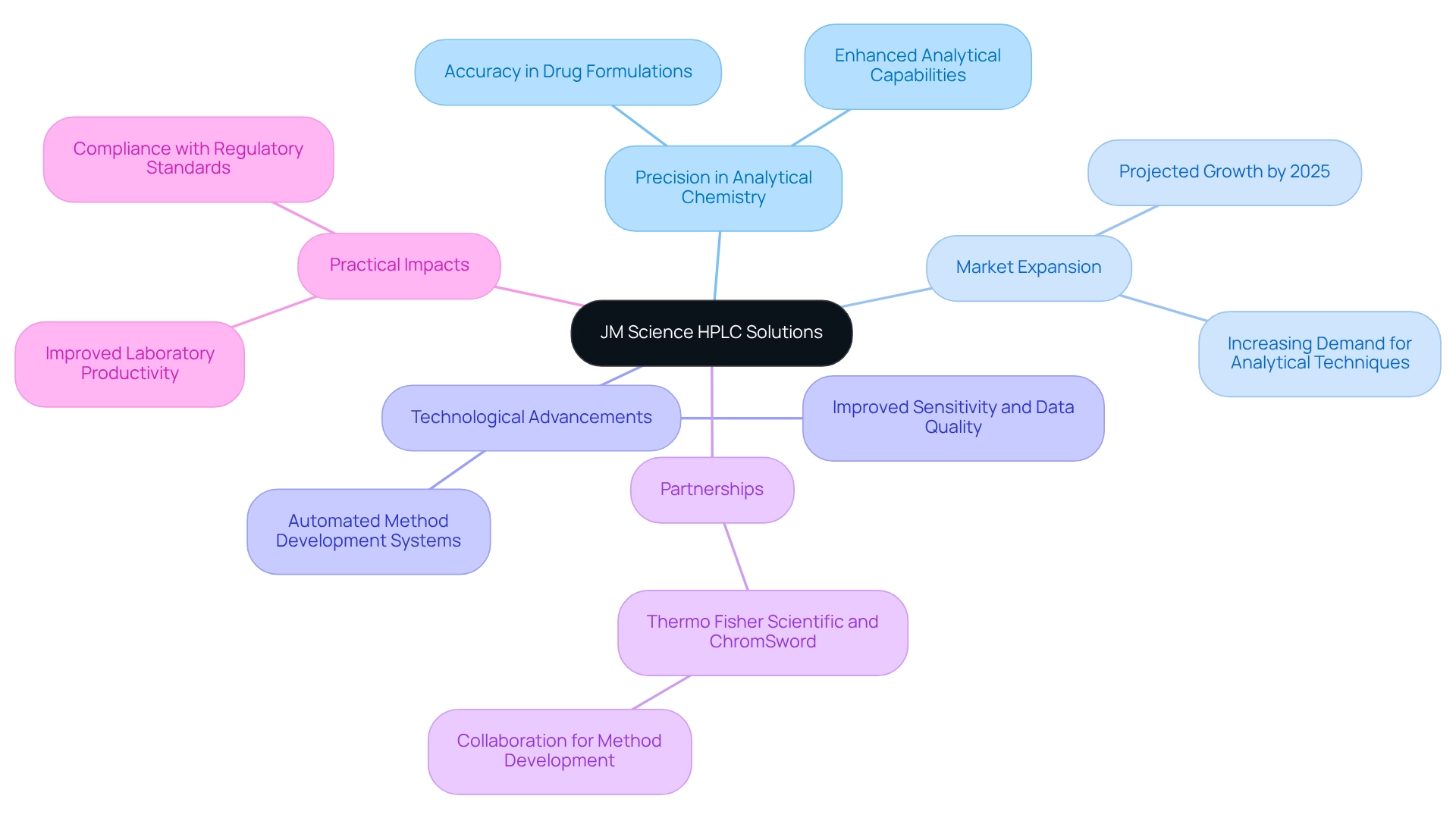
Food Safety Testing: Chromatography's Role in Contaminant Detection
Used chromatography is essential in food safety testing, enabling the detection of contaminants such as pesticides, heavy metals, and pathogens. Techniques like gas chromatography (GC) and liquid chromatography (LC) are used chromatography to analyze food samples, ensuring their safety for consumption. JM Science Inc. stands out by offering premium HPLC columns and accessories that significantly enhance the efficiency and accuracy of these analyses. By precisely identifying harmful substances, laboratories can prevent unsafe items from reaching consumers, thereby safeguarding public health. This application of separation techniques, which used chromatography, is crucial not only for food safety but also for pharmaceutical firms involved in food product testing. JM Science's innovative solutions play a vital role in supporting these critical efforts, reinforcing the importance of high-quality scientific instruments in laboratory settings.
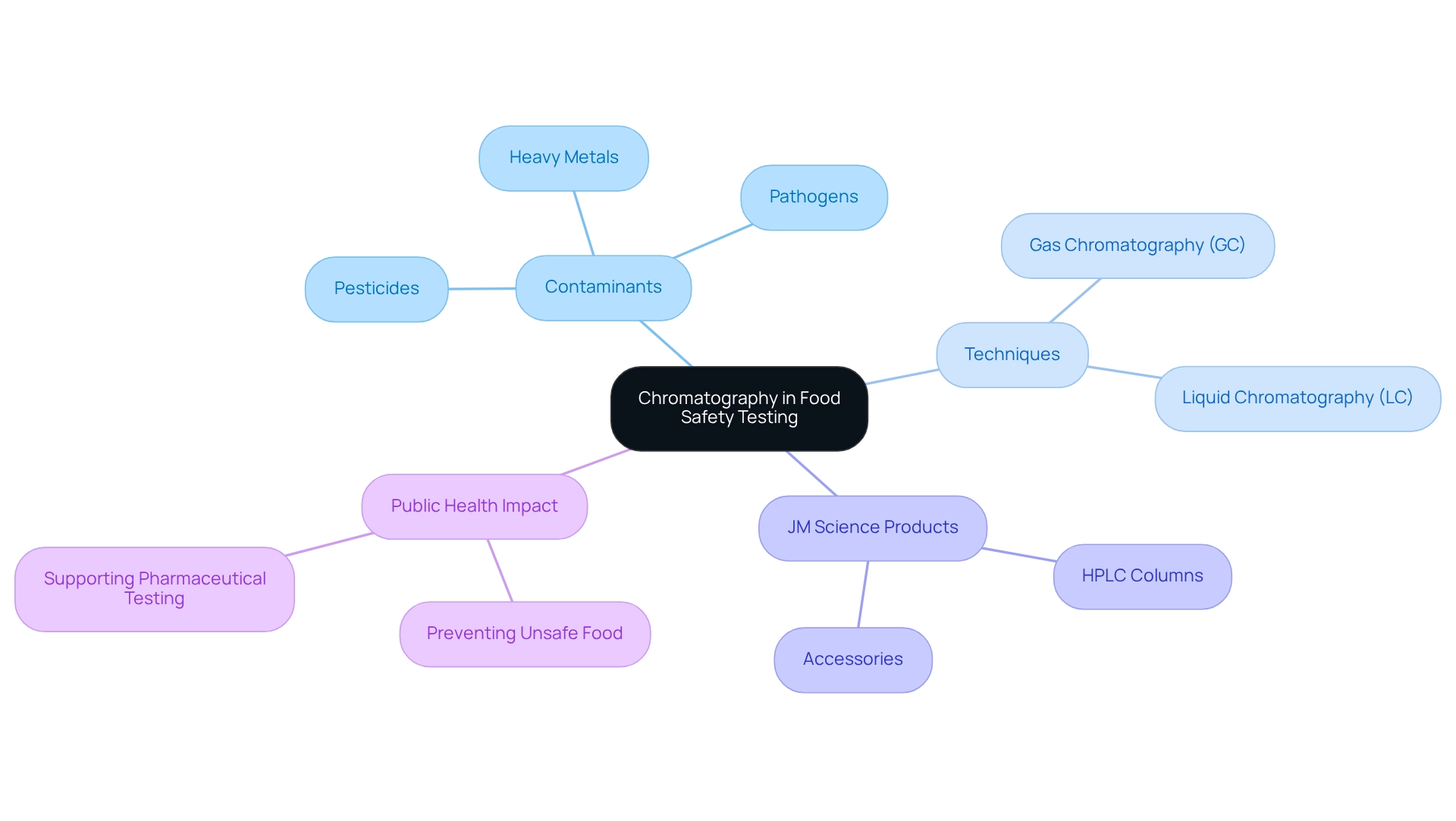
Pharmaceutical Applications: Ensuring Drug Purity with Chromatography
The pharmaceutical industry has used chromatography as a cornerstone, playing a vital role in ensuring drug purity. High-efficiency liquid separation, especially when used chromatography like High-Performance Liquid Chromatography (HPLC), is the preferred technique for examining active pharmaceutical ingredients (APIs) and excipients. This method enables the accurate identification of contaminants that could jeopardize drug safety. In 2025, it is reported that over 85% of pharmaceutical companies used chromatography, particularly HPLC, for API evaluation, underscoring its critical significance in quality control processes.
The application of separation techniques not only verifies that items meet stringent purity criteria but also ensures compliance with regulatory standards established by entities such as the FDA and EMA. This technique, which used chromatography, is indispensable for maintaining the integrity of drug formulations throughout the development process. It facilitates the analysis of impurities and degradation products, which is essential for safeguarding patient safety.
Recent advancements in separation methods, where used chromatography such as Supercritical Fluid Chromatography (SFC) is adopted, reflect a growing commitment to sustainability in pharmaceutical testing. These innovations enhance the efficiency and effectiveness of impurity detection, further solidifying the technique's role in quality assurance programs that used chromatography.
Case studies underscore the importance of chromatographic techniques, specifically how used chromatography in regulatory compliance demonstrates adherence to Good Manufacturing Practices (GMP) and method validation, which fortifies public confidence in drug safety and efficacy. As Dr. Elena Matthews, a prominent regulatory scientist, emphasizes, "Compliance is not just about meeting regulations; it’s about fostering a culture of safety and integrity in all pharmaceutical processes."
In summary, this analytical technique, particularly HPLC, used chromatography to ensure drug purity, adherence to regulations, and ultimately, the safety of patients relying on pharmaceutical products.
Forensic Science Advancements: Utilizing Chromatography for Evidence Analysis
Used chromatography has revolutionized forensic science, offering reliable techniques for the examination of evidence. Among these, gas chromatography-mass spectrometry (GC-MS) is a pivotal method that used chromatography for identifying drugs, toxins, and various substances found at crime scenes. Forensic scientists used chromatography to effectively separate complex mixtures into their individual components, allowing them to accurately determine the presence of specific substances, which is a crucial factor in resolving cases.
Recent statistics indicate that approximately 75% of law enforcement agencies now utilize separation techniques for evidence examination, underscoring their significance in modern investigative practices. The integration of these techniques into criminal investigations, particularly those that used chromatography, not only enhances the reliability of evidence but also solidifies their role as an indispensable resource for law enforcement.
Real-world applications of GC-MS, particularly in analyzing substances from high-profile cases, have showcased its effectiveness in providing critical insights. This advancement in forensic science significantly contributes to the overall efficacy of criminal investigations.

Environmental Monitoring: Chromatography in Pollution Detection
Chromatography is an indispensable tool that is used for environmental monitoring, particularly in detecting pollutants across air, water, and soil samples. Methods such as liquid separation and gas separation are vital for examining environmental samples for contaminants, including heavy metals, pesticides, and volatile organic compounds (VOCs). By accurately identifying and quantifying these pollutants, laboratories can effectively assess environmental health and ensure compliance with stringent regulations.
Recent advancements in separation techniques, notably ultra-high-performance liquid separation (UHPLC) systems, have significantly enhanced analytical capabilities, improving both efficiency and accuracy in laboratory settings. This is especially critical in the realm of environmental pollution detection, where the demand for sensitive analytical methods is paramount. Research has shown that this analytical technique, which uses chromatography, can identify a range of organic substances, including alkanes, alkenes, carbonyls, and volatile fatty acids, essential for understanding pollution dynamics. The impact of separation techniques on pollution detection is underscored by current statistics indicating an increasing reliance on these methods for environmental monitoring in 2025. Experts assert that the integration of automated separation systems is likely to propel further adoption, facilitating more comprehensive environmental assessments. As environmental scientists emphasize the importance of precise pollution identification, this analytical technique remains crucial in safeguarding ecosystems and public health.
Petrochemical Innovations: Chromatography's Impact on Resource Management
In the petrochemical sector, techniques used chromatography are crucial for the analysis of crude oil and its derivatives. Methods such as gas separation are employed to distinguish and identify various hydrocarbon elements, a necessity for quality assurance and resource management. By leveraging these separation techniques, laboratories can optimize refining processes, ensuring that products adhere to industry standards and regulations. This approach not only enhances operational efficiency but also supports sustainable practices in resource management.
Recent statistics indicate that the separation science market within the petrochemical sector is set to experience significant growth by 2025, fueled by an increasing demand for precise analytical techniques. As a prominent chemist aptly stated, "Chromatography is not just a technique; it is a gateway to understanding the complexities of matter." This statement underscores the pivotal role of gas chromatography used chromatography in effective resource management.
Nonetheless, it is essential to recognize the limitations of this analytical technique, including high costs and the requirement for skilled personnel, as highlighted in recent case studies. Real-world applications of gas separation techniques, which used chromatography in crude oil analysis, illustrate their critical importance in ensuring quality control and optimizing resource management within the petrochemical industry.
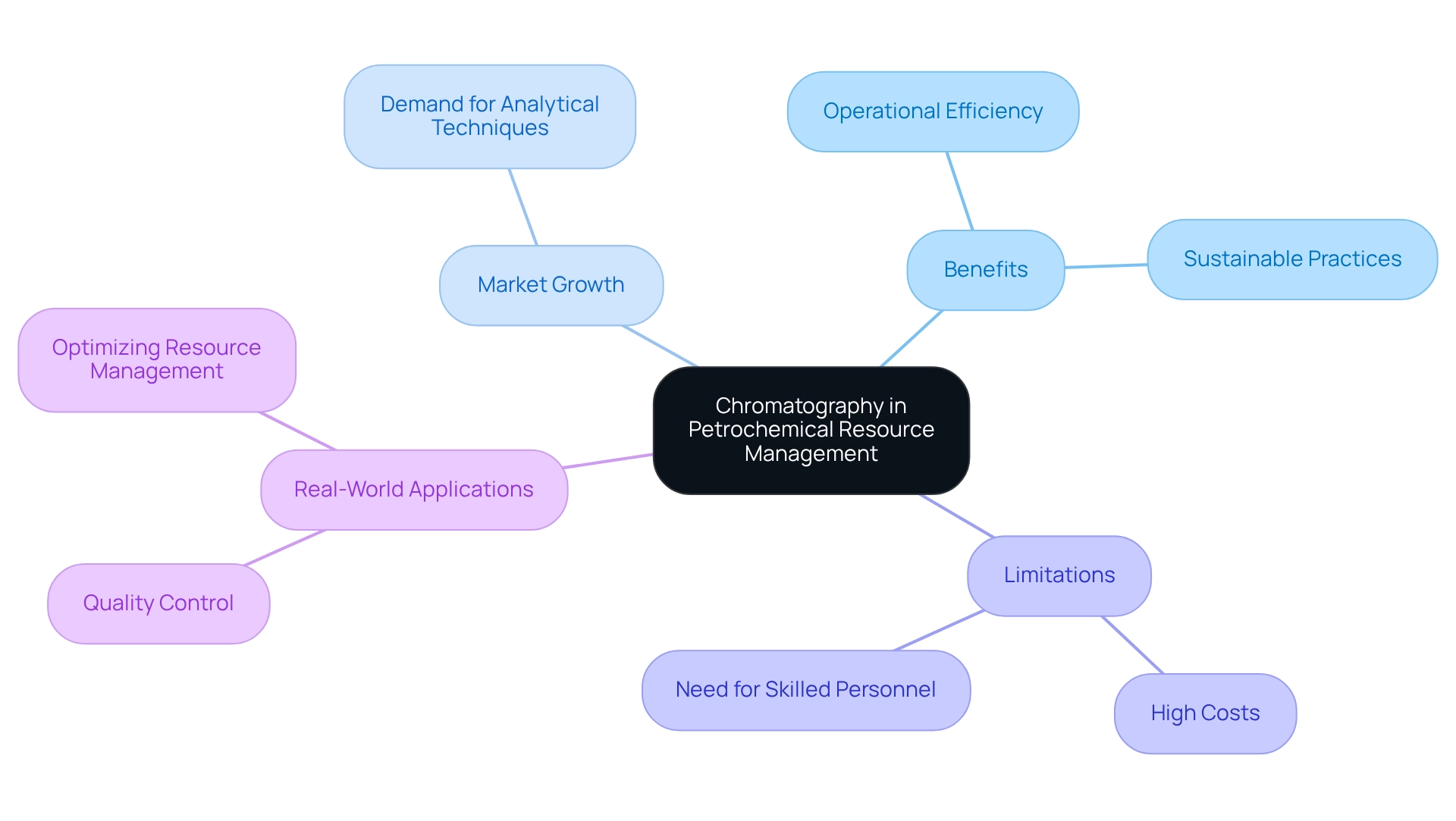
Biotechnology Research: Leveraging Chromatography for Scientific Advancements
In biotechnology research, used chromatography stands as a cornerstone, playing a pivotal role in the separation and purification of biomolecules such as proteins, nucleic acids, and metabolites. Techniques like affinity separation and size-exclusion methods are frequently utilized to isolate specific biomolecules for further investigation. By leveraging these separation techniques, researchers have used chromatography to significantly enhance the accuracy and efficiency of their experiments, driving substantial advancements in critical fields such as drug development and genetic engineering. The application of separation techniques, where used chromatography is a key method, is not merely beneficial; it is essential for fostering innovation within biotechnology.
Current statistics indicate a considerable expansion in the separation technology market, particularly within the biotechnology sector. The compound annual growth rate (CAGR) for this market is projected to be highest in the Asia Pacific region, with countries such as China, India, and Japan leading this growth, bolstered by significant investments in healthcare and biotechnology infrastructure.
Expert insights underscore the transformative impact of separation techniques, particularly how used chromatography contributes to advancements in biotechnology. As stated by Agilent Technologies, Inc., "Agilent combines cutting-edge technology with customer-centric solutions to deliver high-performance analytical tools," highlighting the indispensable role of separation techniques in advancing research methodologies. Moreover, these techniques not only improve biomolecule purification but also catalyze innovation in drug development by enabling researchers to monitor drug stability and identify degradation products—an essential process for ensuring the safety and efficacy of pharmaceutical products.
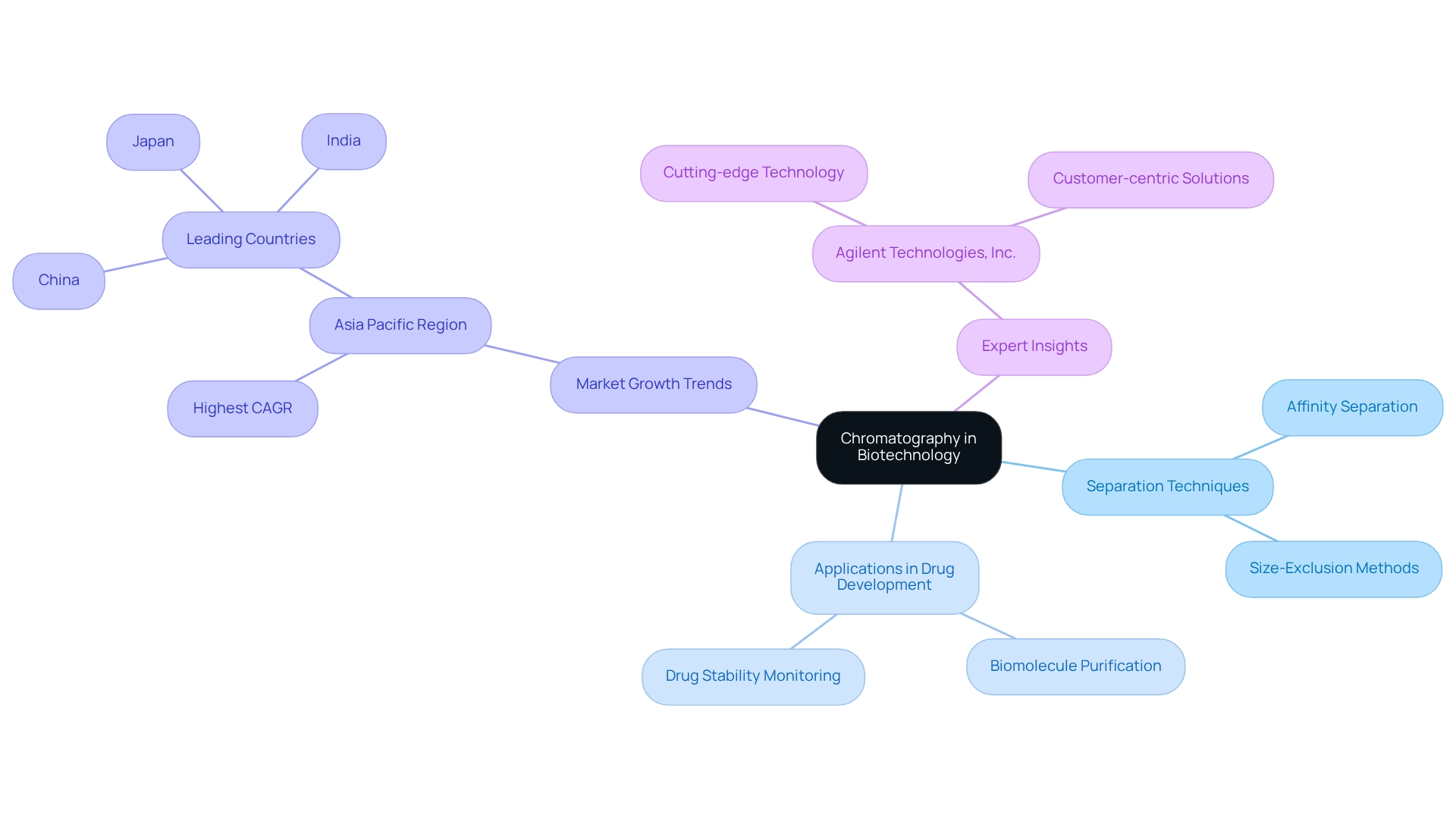
Beverage Industry Quality Control: Chromatography in Flavor Analysis
In the beverage sector, separation techniques that used chromatography play a crucial role in ensuring quality assurance and flavor evaluation. Methods such as gas separation are employed to analyze volatile compounds that contribute to the aroma and flavor of beverages. By accurately identifying and quantifying these compounds, laboratories can guarantee the consistency and quality of their products. This application of separation techniques is vital for maintaining consumer trust and satisfaction in beverage offerings.
Recent studies have demonstrated that gas chromatography (GC) excels in the separation and quantification of compounds, although it does not provide direct insights into compound structures. This limitation highlights the necessity of understanding molecular interactions within the chromatography process. For instance, a case study titled 'Molecular Interactions in Gas Chromatography' illustrates how these interactions affect the movement and separation of compounds, leading to precise evaluations in complex mixtures. Experts in beverage quality assurance emphasize the importance of flavor evaluation through GC, asserting that it is a method that used chromatography effectively preserves the integrity of beverage products. As the beverage industry continues to evolve, the application of separation techniques remains essential for detecting contaminants and developing new products, thereby enhancing overall quality control practices. The integration of advanced separation techniques is expected to further empower organizations, enabling them to excel in analytical capabilities and uphold high standards in flavor evaluation.
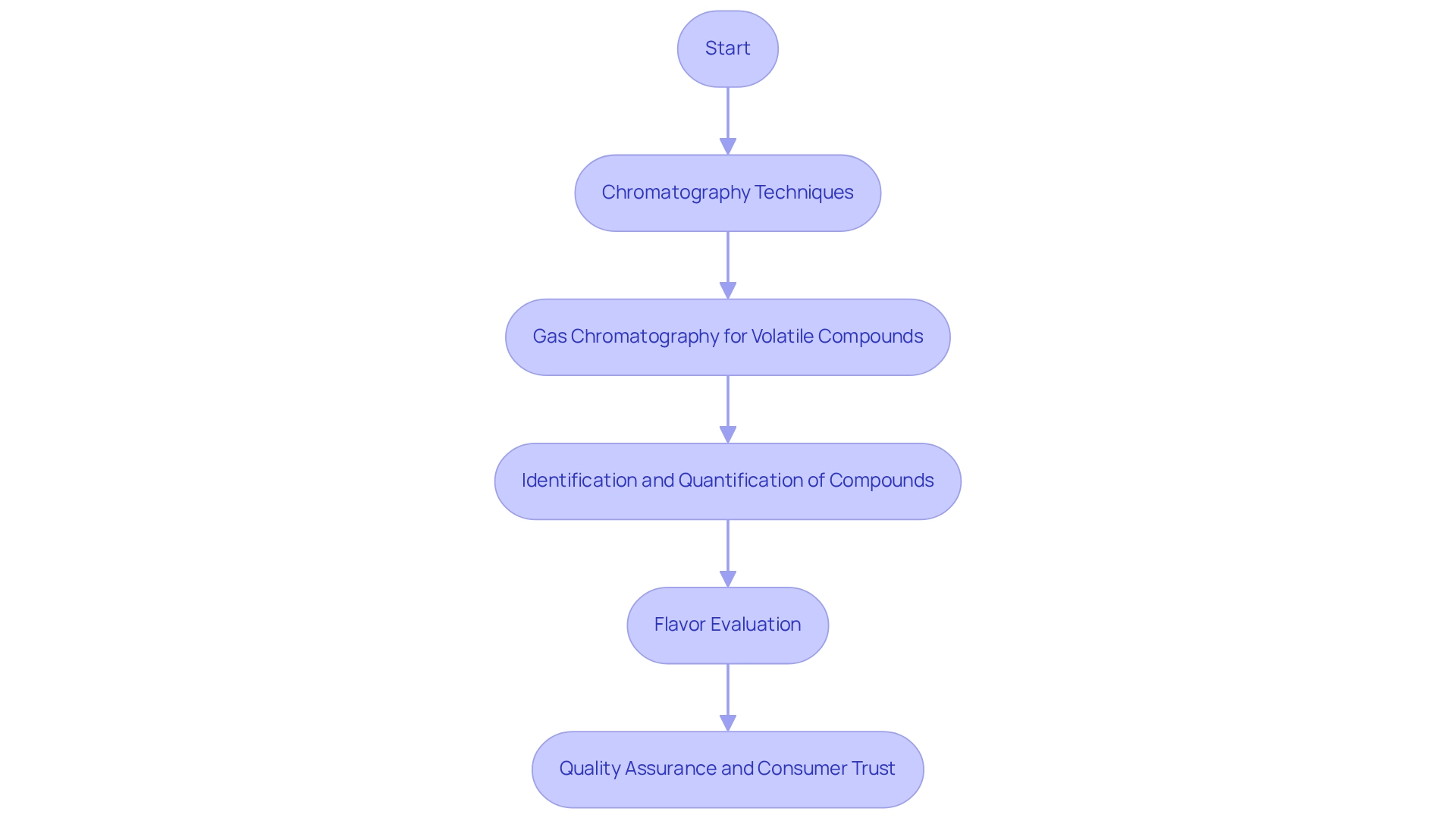
Agricultural Practices: Chromatography in Pesticide Residue Analysis
Chromatography is essential in agriculture, particularly because it is used for analyzing pesticide residues in crops and soil. Techniques such as liquid and gas separation, which use chromatography, are essential for identifying and quantifying pesticide levels, ensuring that agricultural products meet safety standards. For example, advanced platinum nanoparticle probes that use chromatography can achieve a limit of detection (LOD) for parathion as low as 0.002 μg/L, highlighting the sensitivity of contemporary chromatographic methods. By employing these separation techniques, laboratories empower farmers and producers to comply with stringent regulations, thereby safeguarding consumer health and protecting the environment. This application is crucial for fostering sustainable agricultural practices, as it facilitates the detection of harmful residues that could jeopardize food safety, which is achieved as it uses chromatography to enhance effectiveness in agricultural safety testing. Notably, the advent of molecularly imprinted polymers (MIPs) has introduced groundbreaking methods for detecting pesticide metabolites, such as methylphosphonic acid, a byproduct of organophosphate pesticides. Huang et al. have successfully synthesized a molecular imprinted polymer within a microfluidic chip, enabling visualization of this metabolite and demonstrating MIPs' potential to enhance detection capabilities while reducing matrix effects, thus ensuring more reliable outcomes.
Case studies illustrate the practical implications of separation techniques in pesticide residue analysis. A prominent example is Tang et al.'s development of a direct competitive biomimetic ELISA based on MIP membranes for detecting methomyl, a widely used insecticide. Their approach, which uses chromatography, exhibited exceptional stability and anti-interference properties, underscoring its potential for trace pesticide residue examination and its significance in maintaining agricultural safety standards. Expert insights further emphasize the importance of this analytical technique within agricultural practices. Agricultural scientists assert that robust chromatographic methods are crucial for ensuring compliance with safety standards, thereby contributing to the integrity of food supply chains. As the demand for safe agricultural products escalates, the role of separation techniques in pesticide residue analysis becomes increasingly vital. Moreover, advancements in the design of test strips and multichannel detection systems, which facilitate automatic image recognition processing, are paving the way for more efficient and accurate testing methods in the field.
Molecular Biology Studies: Chromatography's Contribution to Genetic Research
In molecular biology, separation techniques that used chromatography are crucial for the analysis of nucleic acids and proteins. High-efficiency liquid separation methods, which used chromatography, such as those provided by JM Science Inc., are employed to isolate and refine DNA, RNA, and proteins for various applications, including gene expression research and protein analysis. JM Science offers an extensive selection of premium HPLC columns and accessories, featuring Shodex, CapcellPak, and Reprosil columns, which significantly enhance the accuracy and efficiency of experimental outcomes. Furthermore, JM Science's titrators and Karl Fischer reagents play an integral role in supporting researchers' analytical requirements. By utilizing these advanced chromatography solutions, researchers used chromatography to drive substantial advancements in genetic research, underscoring the vital role of chromatography in fostering innovation within the field of molecular biology.

Conclusion
The multifaceted applications of chromatography underscore its critical role across diverse industries, including pharmaceuticals, food safety, forensic science, environmental monitoring, and biotechnology. High-performance liquid chromatography (HPLC) emerges as a vital tool, ensuring drug purity and adherence to stringent regulatory standards, ultimately safeguarding patient health. In the food sector, chromatography’s capacity to detect contaminants is pivotal for public health, while in forensic science, it bolsters the reliability of evidence analysis, establishing itself as an indispensable resource for law enforcement.
Furthermore, advancements in chromatography technology, such as ultra-high-performance liquid chromatography (UHPLC) and molecularly imprinted polymers (MIPs), continue to drive innovation across sectors. These innovations enhance analytical efficiency and accuracy while supporting sustainable practices in agriculture and environmental monitoring. The increasing reliance on chromatography reflects its significance in ensuring quality control, safety, and compliance within an ever-evolving regulatory landscape.
As industries advance, the demand for precise analytical techniques is set to rise. The contributions of companies like JM Science Inc. in providing cutting-edge chromatography solutions underscore a steadfast commitment to enhancing laboratory capabilities. By leveraging these innovative tools, laboratories can not only meet but surpass the growing expectations of their fields, propelling progress and ensuring the integrity of products that influence public health and safety. The future of analytical chemistry is undeniably intertwined with advancements in chromatography, solidifying its status as a cornerstone of scientific research and quality control.




